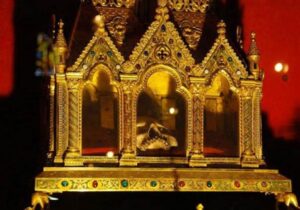The Bishops of Dagon display skulls
The Philistines cut the head of dead King Saul, and kept his skull hanging in the temple of Dagon. The mourning Jews buried the rest of his bones.

A Catholic Bishop adore the skull of “Saint” Wenceslas at the Basilica in Stara Bolesav, just outside Prague.
Like in ancient times of the Philistines, their successors pose the greatest threats to Israel today.
The tragic end of King Saul is the display of his cut of head, or skull, in the pagan Temple of Dagon.
Roman Catholics consider exhumed bodies to be “holy”. Corpses of various kind has been removed from the grave, their head cut off, and the cleansed skulls put up for veneration and adoration.
Just like in the pagan temple of Dagon.
1 Chronicles 10:8-11
The next day, when the Philistines came to strip the dead, they found Saul and his sons fallen on Mount Gilboa. They stripped him and took his head and his armor, and sent messengers throughout the land of the Philistines to proclaim the news among their idols and their people.
They put his armor in the temple of their gods and hung up his head in the temple of Dagon.
When all the inhabitants of Jabesh Gilead heard of everything the Philistines had done to Saul, all their valiant men went and took the bodies of Saul and his sons and brought them to Jabesh. Then they buried their bones under the great tree in Jabesh, and they fasted seven days.
Various heads displayed by Vatican priests:

The skull of “Saint” Valentine in The Church is Chiesa di Santa Maria in Cosmedin in Rome, Italy.

The disconnected head of St.Oliver Plunkett” in Church in Drogheda in Ireland.

This holy skull is displayed in Saint-Victor Abbey in Marseilles in France.

The skull of Thomas Aquinas in the Cathedral of Priverno, near Rome. Priverno is next to Fossanova.

The skull of St. Yves is kept for display in the Cathedral of Tréguier in Brittany in France.

The skull of Saint Mendita is placed on the wall of St. Peter’s Church in Munich.

St.Cathrine of Bologna in Corpus Domini Sanctuary in Italy.

The Basilica of St. Agnes in Rome.

“Saint” Wenceslas at the Basilica in Stara Bolesav, just outside Prague.
The Philistines and the Roman Catholics have a lot in common.
Since the Temple of Dagon existed 2.500 B.C, there is very few reliable drawings of this temple and a “god” named Dagon. But since the Philistines were intruders from the island of Crete and fishermen, many historians believe Dagon was the “fish god”.Here are some illustrations:

An ancient wall painting of the fish god, and a modern illustration.
